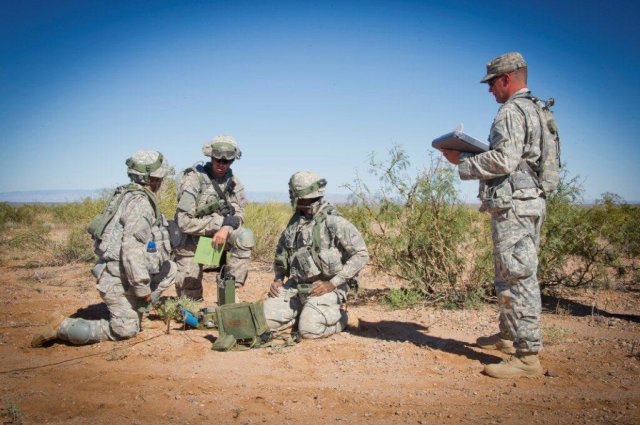
Eloise Lundgren
ABERDEEN PROVING GROUND, Md. (Dec. 11, 2012) –Testers, Soldiers, engineers and combat developers completed the fourth iteration of a series of semi-annual field exercises, called Network Integration Evaluations, at Fort Bliss, Texas, and White Sands Missile Range, N. M., just in time to get everyone home for the holidays.
Managed by a group known as the Network Integration Evaluation, or NIE, “TRIAD”– Army Test and Evaluation Command, System of Systems Integration Directorate and Brigade Modernization Command — NIE 13.1 included several program tests for record, additional tests for record from distributed sites and less formal assessments called SUEs, which is short for Systems Under Evaluation. NIEs are designed to integrate and mature the Army’s tactical network and accelerate the way network technologies are delivered to soldiers through integrated “capability sets” of communications gear.

Testers, Soldiers, engineers and combat developers completed the fourth iteration of a series of semi-annual field exercises, called Network Integration Evaluations, at Fort Bliss, Texas, and White Sands Missile Range, N. M., just in time to get everyone home for the holidays. (Photo Credit: U.S. Army photo)
“The pace of NIEs is fast,” said Col. Joseph Martin, commander, U.S. Army Operational Test Command, an ATEC subordinate command. “With one NIE executed every six months and others simultaneously in various stages of planning, the coordination of effort among the multiple Army organizations and industry partners is monumental.”
“But with this iteration being the fourth in the series,” Martin continued, “we were able to apply lessons learned from the three previous NIE’s and streamline our integration efforts on this one.”
The Army applied several lessons learned from NIE 12.2, such as system of systems training for Soldiers, streamlined testing, upfront integration of hardware and instrumentation, increased industry participation, and reduced individual system costs, re-engineering costs and infrastructure costs, he explained.
With OTC’s Integrated Test and Evaluation Directorate, led by Col. Dave Wellons, taking the lead on NIE 13.1 for ATEC, nearly 5,000 Soldiers, Department of the Army Civilian employees and contractors converged in the desert along the borders of west Texas and eastern New Mexico, joined by the 1st Armored Division’s 2nd Brigade. Soldiers with 2/1 AD, as the test player unit, executed training scenarios that helped determine whether systems and equipment were effective, suitable and survivable, Martin said.
Some of the equipment, systems and technology operational testers looked at included Nett Warrior (ground soldier communication system), M109 Paladin Integrated Management, or PIM, artillery system, Spider networked munitions system, Joint Battle Command-Platform communication system, and the RAM Warn (counter rocket, artillery, mortar system), Wellons said.
Col. Quinton Arnold, director, OTC’s Maneuver Test Directorate, led the efforts of managing systems under test.

Testers, Soldiers, engineers and combat developers completed the fourth iteration of a series of semi-annual field exercises, called Network Integration Evaluations, at Fort Bliss, Texas, and White Sands Missile Range, N. M., just in time to get everyone home for the holidays. (Photo Credit: U.S. Army photo)
“It’s all about the data and operational realism,” Arnold said. “Our test teams, working with BMC and the player unit, did a lot of excellent work to ensure these two elements were maintained, resulting in a successful operational test.”
The final report by ATEC-AEC will help Army leaders to make acquisition decisions, according to Robin Boggs, ATEC public affairs officer.
NIE 13.1 was Martin’s first experience with the semi-annual series since taking command of OTC in July, and it was truly a team effort, he said.
“Everyone involved in this effort makes each NIE successful because they are willing to put aside their organizational allegiances for the sake of a better-integrated solution for the soldier,” Martin said. “Everyone realizes the importance of remaining flexible as the NIE process continues to evolve.”
According to Martin, although ATEC was the senior TRIAD partner, ATEC’s commanding general, Maj. Gen. Genaro Dellarocco, gave OTC the primary role of executing the NIE mission.
“I don’t think we could find a more professional group of people than those from the System of Systems Integration Directorate, Brigade Modernization Command and of course the Army Test and Evaluation Command to execute this mission,” Wellons said.







